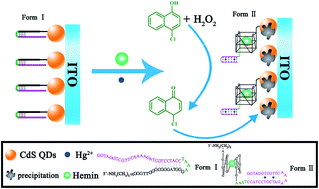A photoelectrochemical DNA sensor for the detection of Hg2+ based on Hg2+-mediated oligonucleotide switching
Abstract
A sensitive photoelectrochemical (PEC) method for Hg2+ detection is reported, based on the Hg2+-mediated structural switch of an oligonucleotide strand and biocatalytic precipitation (BCP) on a CdS quantum dot electrode. The principle is that, in the absence of Hg2+, the oligonucleotide strand forms a stem-loop, thus a G-rich sequence in the strand is partially caged in the stem-loop structure and cannot fold into a G-quadruplex. While in the presence of Hg2+, the T–Hg2+–T coordination leads to the formation of another stem-loop structure and allows the G-rich sequence to fold properly and bind hemin to form a stable G-quadruplex/hemin complex, which could accelerate oxidation of 4-chloro-1-naphthol (4-CN) by H2O2 to yield the insoluble (BCP reaction) and insulating product benzo-4-chlorohexadienone on the photoelectrode, thereby efficiently causing the change in the photocurrent signal. This simple PEC sensor could detect aqueous Hg2+ at concentrations as low as 4 nM with high selectivity.


 Please wait while we load your content...
Please wait while we load your content...